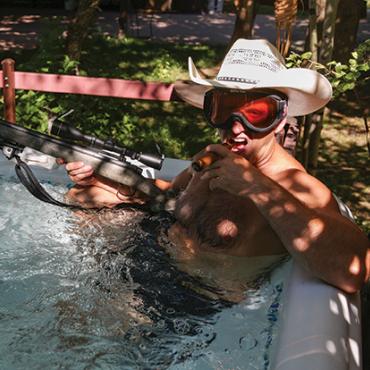Leading the Way
When it comes to local controversies, last year’s announcement of the Yellowstone Park snowmobile phase-out is hard to beat for right-wing rancor, left-wing quixotism, and just about every reaction and viewpoint in between. But while the condemnatory salvo from West Yellowstone merchants came fast and hard, one local business owner had surprisingly little to say. It seems that unlike many of his snowmobile- and tourist-dependent neighbors, Bill Howell, owner of the West Yellowstone Conference Hotel, had seen this all coming—and had already begun to adapt.
“Back in early 1999, when all the snowmobile studies were going on in the park, we realized that the four-stroke snowmobile was the right thing to do for the environment,” Howell explains. “So we put the pressure on Arctic Cat to produce a cleaner machine.” By the time winter rolled around, Howell was already running a cleaner, quieter snowmobile into the Park—something few other motels and rental shops had even talked about, let alone accomplished. “We had the first two prototypes,” Howell says, “and we just went from there.”
Today, the Conference Hotel commands a fleet of 100 four-stroke Arctic Cat snowmobiles, all available for daily trips into Yellowstone. These are in addition to their pre-existing inventory of two-stroke snowmobiles, rented out for forays into the sprawling National Forest land adjoining West Yellowstone. The new sleds may not be as fast as their controversy-causing forebears, but they get better gas mileage, don’t burn oil, and last longer. So from a pragmatic, nonenvironmental standpoint, says Howell, “they’re economically feasible too. The bottom line is pretty much the same.”
What are Howell’s predictions for the future? “It’s really just a matter of technology,” he explains, comparing four-stroke engines to the catalytic converter of the early 90s. “Dirty, noisy two-stroke engines will be phased out over time. Yamaha has had four-stroke snowmobiles for years—they’re probably just waiting for the right time to release them. Eventually, with the right technology, two-strokes could become cleaner than these four-strokes we have today.”
“Back in early 1999, when all the snowmobile studies were going on in the park, we realized that the four-stroke snowmobile was the right thing to do for the environment,” Howell explains. “So we put the pressure on Arctic Cat to produce a cleaner machine.” By the time winter rolled around, Howell was already running a cleaner, quieter snowmobile into the Park—something few other motels and rental shops had even talked about, let alone accomplished. “We had the first two prototypes,” Howell says, “and we just went from there.”
Today, the Conference Hotel commands a fleet of 100 four-stroke Arctic Cat snowmobiles, all available for daily trips into Yellowstone. These are in addition to their pre-existing inventory of two-stroke snowmobiles, rented out for forays into the sprawling National Forest land adjoining West Yellowstone. The new sleds may not be as fast as their controversy-causing forebears, but they get better gas mileage, don’t burn oil, and last longer. So from a pragmatic, nonenvironmental standpoint, says Howell, “they’re economically feasible too. The bottom line is pretty much the same.”
What are Howell’s predictions for the future? “It’s really just a matter of technology,” he explains, comparing four-stroke engines to the catalytic converter of the early 90s. “Dirty, noisy two-stroke engines will be phased out over time. Yamaha has had four-stroke snowmobiles for years—they’re probably just waiting for the right time to release them. Eventually, with the right technology, two-strokes could become cleaner than these four-strokes we have today.”






